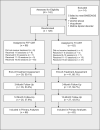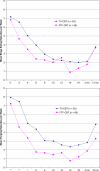A randomized trial comparing the efficacy of cognitive-behavioral therapy for bulimia nervosa delivered via telemedicine versus face-to-face
- PMID: 18374304
- PMCID: PMC2633728
- DOI: 10.1016/j.brat.2008.02.004
A randomized trial comparing the efficacy of cognitive-behavioral therapy for bulimia nervosa delivered via telemedicine versus face-to-face
Abstract
Objective: A major problem in the delivery of mental health services is the lack of availability of empirically supported treatment, particularly in rural areas. To date no studies have evaluated the administration of an empirically supported manual-based psychotherapy for a psychiatric condition via telemedicine. The aim of this study was to compare the relative efficacy and acceptability of a manual-based cognitive-behavioral therapy (CBT) for bulimia nervosa (BN) delivered in person to a comparable therapy delivered via telemedicine.
Method: One hundred twenty-eight adults meeting DSM-IV criteria for BN or eating disorder-not otherwise specified with binge eating or purging at least once per week were recruited through referrals from clinicians and media advertisements in the targeted geographical areas. Participants were randomly assigned to receive 20 sessions of manual-based, CBT for BN over 16 weeks delivered either face-to-face (FTF-CBT) or via telemedicine (TV-CBT) by trained therapists. The primary outcome measures were binge eating and purging frequency as assessed by interview at the end of treatment, and again at 3- and 12-month follow-ups. Secondary outcome measures included other bulimic symptoms and changes in mood.
Results: Retention in treatment was comparable for TV-CBT and FTF-CBT. Abstinence rates at end-of-treatment were generally slightly higher for FTF-CBT compared with TV-CBT, but differences were not statistically significant. FTF-CBT patients also experienced significantly greater reductions in eating disordered cognitions and interview-assessed depression. However, the differences overall were few in number and of marginal clinical significance.
Conclusions: CBT for BN delivered via telemedicine was both acceptable to participants and roughly equivalent in outcome to therapy delivered in person.
Figures
References
-
- Agras WS, Walsh T, Fairburn CB, Wilson GT, Kraemer HC. A multicenter comparison of cognitive–behavioral therapy and interpersonal psychotherapy for bulimia nervosa. Archives of General Psychiatry. 2000;57:459–466. - PubMed
-
- Arnow BA. Why are empirically supported treatments for bulimia nervosa underutilized and what can we do about it? Journal of Clinical Psychology. 1999;55:769–779. - PubMed
-
- Bakke B, Mitchell JE, Wonderlich S, Erickson R. Administering cognitive–behavioral therapy for bulimia nervosa via telemedicine in rural settings. International Journal of Eating Disorders. 2001;30:454–457. - PubMed
-
- Beck AT, Ward CM, Mendelson M, Mock JE, Erbaugh JK. An inventory for measuring depression. Archives of General Psychiatry. 1961;44:1210–1218. - PubMed
-
- Cluver JS, Schuyler D, Frueh BC, Brescia F, Arana GW. Remote pspychotherapy for terminally ill cancer patients. Journal of Telemedicine and Telecare. 2005;11:157–159. - PubMed
Publication types
MeSH terms
Grants and funding
LinkOut - more resources
Full Text Sources
Other Literature Sources
Medical




